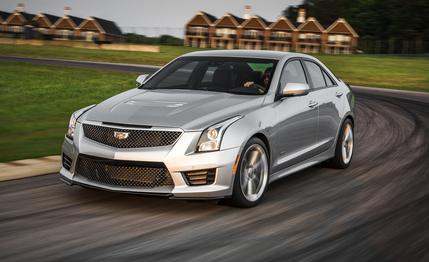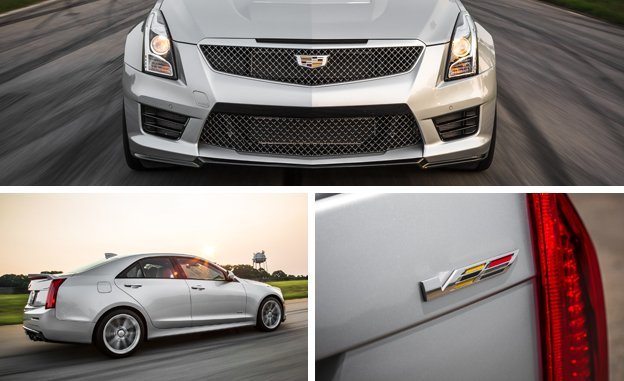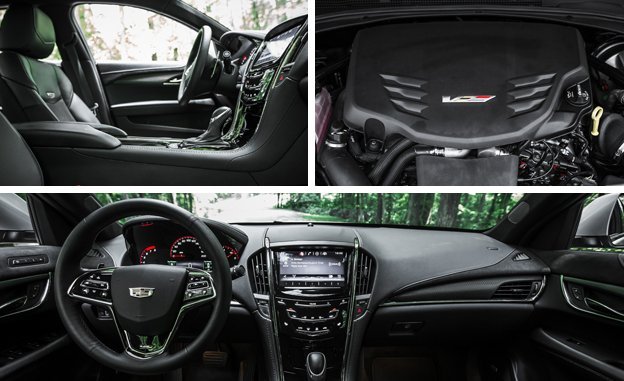
 Instrumented Test
Instrumented Test
The chassis guys at Cadillac need to sit down with the designers. An intervention is in order. Maybe we can help.
Engineering is responsible for the ATS-V’s superlative chassis, which features steering, brakes, suspension, and tires that work in symphonic harmony. There are simply no atonal notes as the ATS-V moves down the road. Each instrument is perfectly tuned and balanced and feels just right. This car, engineered and built in Michigan, flat-out feels better, is easier to drive quickly, and is more fun than the BMW M3 and the Mercedes-AMG C63. German chassis engineering has met its match.


The chassis’ righteousness and the joy it generates never diminish. It doesn’t matter if you’re plucking through a canyon road, banging on a racetrack, or humming straight down I-5 with the cruise set at 75. But while the chassis is delightful, a dull interstate drive is when the interior’s dissonance begins to annoy. A mishmash of materials, textures, and finishes, it has all the restraint and editing of a Mardi Gras float. Optional, $2300 Recaro chairs—absent on our photo car, which also lacked the $6195 Track Performance package of the ATS-V we ran numbers on—are supportive and look great, but don’t examine them too closely or you might notice that the leather is pulling away. And make sure that you spec the $300 microsuede-wrapped steering wheel or you’ll get a leather covering that might as well be vinyl. Beyond the steering wheel are gauges that are more appropriate for a Chevy Cruze; Lexus did better gauges 25 years ago. At least the large rectangular information display is a better balance of form and function.
The same can’t be said of the large touch-screen infotainment system, dubbed CUE. Often unresponsive and difficult to operate at speed, the screen actually manages complex commands like entering a destination into the optional navigation system with well-thought-out logic. What ends up annoying is the stuff you do constantly, like adjusting the volume with the touch-sensitive “slider” or changing radio stations or tracks. Functions that should require a quick tap of the screen end up requiring two, three, or a punch. Meanwhile, you’ve wandered onto the rumble strips.
Rumblings from the back-seat occupants also are inevitable. They’ll likely complain about the lack of legroom, the high beltline, and how hard it is to get in and out due to the small door opening. From the driver’s seat, the ATS-V’s design negatively affects outward visibility. Cadillac design clearly won over practicality. Mercedes’ C63 and the BMW M3 don’t compromise usability and practicality nearly as much as Cadillac. But at the same time, the Germans don’t build roadgoing concept cars—Cadillac does. Still, the beauty of the ATS-V is outweighed by the annoyances it creates.


We can’t find major faults with the 464-hp twin-turbocharged V-6 under the vented hood. Closely related to the 420-hp engine in the CTS Vsport, the ATS-V’s powerplant has lighter turbocharger turbines that improve response time. There’s a slight grittiness as the engine spins past the 3500-rpm torque peak, but it’s only really noticeable if you’ve recently driven, say, the silky V-8 of the Mercedes-AMG C63 S. All 445 lb-ft of the 3.6-liter’s torque arrive in a steady and linear manner that belies the engine’s force-fed reality. Instead of bum-rushing the driveline with a massive wave of torque, the engine acts more like a large-displacement, naturally aspirated big-block. With the eight-speed automatic doing the shifting, the ATS-V sedan hit 60 mph in 3.9 seconds, three-tenths quicker than the manual ATS-V coupe.
Now it’s time for us to intervene. Cadillac, we can’t sit idly by and enable these design lapses. You have a problem and you must admit it. The designers need editing and it’s time to do something about it—it’s not fair to the engineers who made the ATS-V the best-driving car in its class.